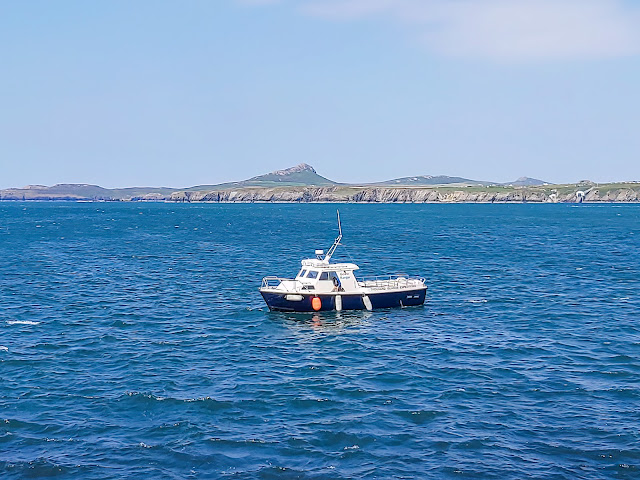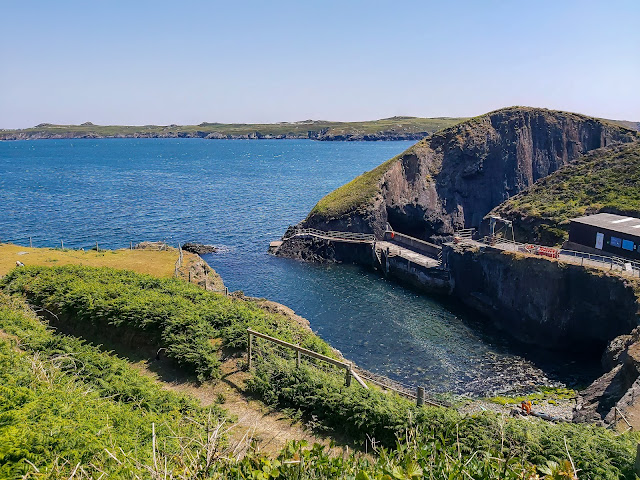On 7th June 2023, I spent a large part of the day on RSPB Ramsey Island.
However, I also visited the following site: Stack Rocks on the Pembrokeshire Coast Path.
My pre-booked boat trip to RSPB Ramsey Island with Thousand Islands Boat Trips departed from St. Justinian lifeboat station, just a few minutes drive from my overnight stay at Rhosson campsite. The car park located in a nearby field provided sightings of Stonechat (male and female), Sedge Warbler (1 singing male) and Kestrel (1) whilst I waited to check in for the boat trip.
Photo: view from the car park at St. Justinian looking towards RSPB Ramsey Island
RSPB Ramsey Island is located just 1 mile off the St Davids peninsula and a 3.5 mile trail, tough going and rugged in some places, provides a route around it. The summits of Carn Ysgubor and Carn Llundain give amazing views east to the mainland, south to Skomer Island and, on the clearest of days, west to Ireland.
Photo: view from RSPB Ramsey Island looking over Ramsey Sound to St. David's peninsula
At nearly 400 feet high in some places, the western cliffs on RSPB Ramsey Island are among the highest in Wales. These provide nesting sites for breeding Guillemots, Razorbills, Kittiwakes, Fulmars, Choughs and Ravens. A large Atlantic Grey Seal colony lives around the island, with pups born in September and October, and Harbour Porpoise often feed in Ramsey Sound.
Other habitats in the interior of the island include grassland and heathland providing breeding habitat for Wheatears, Stonechats, Meadow Pipits, Linnets and Skylarks.
In 1999/2000 RSPB Ramsey Island was finally cleared of the Brown Rats that had decimated the island's bird populations for 100 years. The highest standards of bio-security are still maintained in order to ensure rats and mice, which have disastrous impacts on seabird colonies, are never re-introduced to the island again.
The undoubted highlight of my visit to RSPB Ramsey Island was undoubtedly the abundance of Choughs. I had sightings of 13 birds but this may have involved some double-counting.
The numbers of seabirds that I saw was relatively modest compared with other breeding sites in England, Wales and Scotland that I have visited but I think that was because sightings were limited to birds on the sea or flying offshore rather than readily visible on nesting ledges.
The most surprising sighting was of a Red Kite being hotly pursued and harassed by 2 Oystercatchers! However, I failed to see any of the 2 pairs of nesting Peregrines.
The highlights during my visit were as follows: Chough (13), Raven (1), Red Kite (1), Guillemot (at least 100), Razorbill (at least 50), Fulmar (at least 100), Kittiwake (4), Gannet (4), Cormorant (5), Greater Black-backed Gull, Herring Gull, Oystercatcher (17), Wheatear (at least 20), Swallow (at least 10), House Martin (at least 10), Rock Pipit (at least 10), Linnet (c.20), Stonechat (1), Pied Wagtail (1), Atlantic Grey Seal (3), Rabbit (7)
Photo: Fulmar
Photo: Fulmars
Photo: Fulmar
Photo: Guillemots
Photo: Wheatear
Photo: Wheatear
Photo: juvenile Wheatear
Photo: Wheatear
Photo: Wheatear
Photo: Wheatear
Photo: juvenile Wheatear
Photo: Wheatear
Photo: Meadow Pipit
Photo: Meadow Pipit
Photo: Red Kite
Photo: Red Kite .... and angry Oystercatchers!
Photo: Red Kite .... and angry Oystercatchers!
Photo: Red Kite .... and angry Oystercatchers!
Photo: Red Kite .... and angry Oystercatcher!
Photo: Rabbit
Photo: Atlantic Grey Seal
Photo: Atlantic Grey Seal
After spending an extremely enjoyable but muscle-aching morning and afternoon on RSPB Ramsey Island, I drove 38 miles and 1:15 hours back down to the south Pembrokeshire coast again, specifically to Stack Rocks.
Stack Rocks is yet another spectacular stretch of the Pembrokeshire coast but unfortunately it is frequently inaccessible since the minor road that reaches it crosses the Castlemartin MOD firing range that has been in use since the 1940s .... see here and here. Early evening on 7th June 2023 was the only time the access road was open during my trip.
Stack Rocks, also known as Elegug Stacks (elegug is the Welsh name for the Guillemot), are 2 detached pillars of limestone. The tops of the stacks and the ledges below provide breeding sites for Guillemots and Razorbills which can easily be seen from the cliff-top path. The views of these breeding seabirds was much closer than those on RSPB Ramsey Island.
The highlights during my visit were as follows: Guillemot (+++), Razorbill (at least 10), Gannet (2), Shag (3), Rock Pipit (1)
Here are some photos from my visit ....
Photo: Stack Rocks
Photo: Guillemots
Photo: Guillemots
Photo: Guillemots
Photo: Guillemots
Photo: Guillemots
Photo: Guillemots
Photo: Guillemots
Photo: Lesser Black-backed Gull
After my visit to Stack Rocks, I did not drive directly back to Rhosson campsite but instead took a detour via Martins Haven in the far west. This is the location for boat trips to Skomer Island but in the evenings there is the possibility of seeing huge numbers of "rafting" Manx Shearwaters waiting for darkness before returning to their nesting burrows. I failed to see a single Manx Shearwater from my viewpoint at Wooltack Point overlooking Jack Sound and Skomer Island but I was rewarded with a stunning sunset.
Photo: sunset from Wooltack Point
#DefendNature .... Please help save and enhance our laws that protect our environment and wildlife
















































No comments:
Post a Comment
If you feel like commenting on my blog, you can contact me by completing the comment form below. I will respond to all comments and enquiries and constructive criticism will always be welcomed.